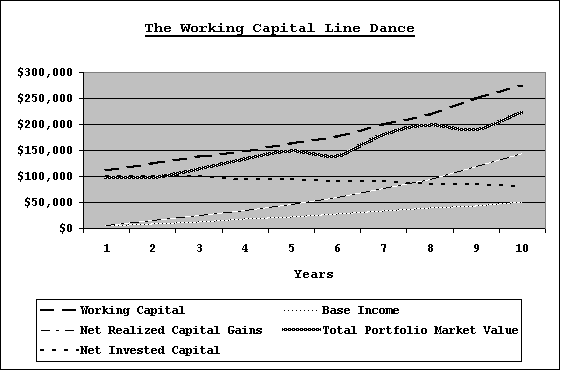It matters not what lines, numbers, indices, or gurus you worship, you just can't know where the stock market is going or when it will change direction. Too much analytical effort is wasted trying to predict course corrections… even more is squandered comparing changes in portfolio "market value" with unrelated indices and averages.
If we reconcile in our minds that we can't predict the future (or change the past), we can move through the uncertainty more productively. Let's simplify portfolio performance evaluation by using information that we don't have to speculate about, and which is related to our own personal investment programs.
Why has it become vogue to think of investment portfolios as sprinters in a twelve-month race with an array of indices and averages? Because an unhappy investor is Wall Street's best friend, and by emphasizing short-term results in a superbowlesque environment, the vast majority of investors will be unhappy about something, all of the time.
To personalize your performance evaluation protocol, you just need to focus your attention on two, longer-range, objectives:
· Growing your productive "working capital", and
· Increasing your "base income".
Neither objective is directly related to market averages, interest rate movements, market values, or the calendar year. But with this focus, investors can protect themselves from the short-term thinking associated with daily events and "expert" analyses. Objective based performance analysis is less frantic, less competitive, and more constructive than conventional methods... so let's define our terms.
Briefly, "working capital" is the total cost basis of the securities and cash in the portfolio, and "base income" is the total of dividends and interest that the portfolio produces. Deposits and withdrawals, capital gains and losses, directly impact the working capital number, and indirectly, the base income.
Securities become non-productive when they are no longer Investment Grade Value Stocks (IGVS), or no longer income producing. Good sense management can minimize these unpleasant experiences.
Let's develop an "all you need to know" chart that will help you manage your way to goal achievement in a low failure rate, unemotional, environment. The chart will have four data lines, and your portfolio management objective will be to keep three of them moving ever upward through time.
Note that a separate record of deposits and withdrawals (the only downward moving line on the chart) should be maintained. If you are paying fees or commissions separately from your transactions, consider them withdrawals of "working capital". If you don't have specific selection criteria and profit taking guidelines, you need to develop them.

Click here to view the "working capital line dance".
Line One charts your "working capital", and an average annual growth rate between 5% and 10% would be a reasonable target, depending on asset allocation. (An average cannot be determined until after the second full year, and a longer period is recommended to allow for compounding.)
Note that the working capital line should be an upward only line (Did that raise an eyebrow?) It is increased by dividends, interest, deposits, and realized capital gains and decreased by withdrawals and realized losses.
· There are two basic truths at the bottom of this: You just can't make too much money, and there's no such thing as a bad profit. Don't pay a CPA who recommends loss taking on high quality securities; explain that you are helping him reduce his own tax burden.
Line Two reports "Base Income", and it too will always move upward if you are managing your asset allocation properly. The only exception could be a 70% (or higher) equity allocation, where the emphasis is on a more variable source of income… the dividends on a constantly changing stock portfolio.
· This "expert" suggests a maximum 60% equity allocation as a key to eventually achieving retirement income readiness.
Line Three is labeled: Cumulative Net Realized Capital Gains. This total is most important during the early years of portfolio building and it will directly reflect both the security selection criteria you use, and the profit taking rules you employ... look inward if this line is not growing in all market environments.
If you build a portfolio of IGVSs, and apply a maximum 5% of cost basis diversification rule, you will rarely have a downturn in this monitor of both your selection criteria and your profit taking discipline. Unless your selection criteria is too conservative, there will always be something out there worth buying with the proceeds.
· Three 8% singles will produce a larger number than one 25% home run, and which is easier to obtain? The growth in Line Three should accelerate in rising markets. Base income just keeps growing because asset allocation is based on the cost basis of each security class… get it? At least 40% of every income dollar is reallocated to income purpose securities.
One other important detail: no matter how conservative your selection criteria, a security or two is bound to become a loser. Don't judge this by Wall Street popularity standards, tea leaves, or analyst opinions. Let the fundamentals (profits, S & P rating, dividend action, etc) send up the red flags.
This brings us to Line Four, the change in Total Portfolio Market Value over the course of time. This line will follow an erratic path, constantly staying below your Working Capital.
If you study the chart after a market cycle or two, you will see that lines one through three move steadily upward regardless of what line four is doing. BUT, you will also notice that the lows of line four begin to occur above earlier highs.
Line four will rarely be above line one, but when it begins to close the gap, a greater movement upward in Line three (Net Realized Capital Gains) should be expected. In 100% income purpose portfolios, it is possible for market value to exceed working capital by a slight margin, but it is much more likely that you are ignoring some profit taking opportunities.
· Don't let this happen. Studies show that far too many unrealized gains are brought to the Schedule D as realized losses... and this includes potential profits on income securities. If you can "net" a year's interest in advance (or 5%) on an income purpose security, reel it in without hesitation.
· When your portfolio hits a new "market value" high, look around for a growth purpose security that no longer boasts IGVS status and bite that bullet.
What's different about this approach, and why isn't it more high tech? Why is there no mention of the popular market indices, or comparison with anything except your very own, personal, reasonable, goals?
This method gets you where you want to be without any hype or non-productive transactions. It provides a valid use for portfolio market value, as both an expectation clarifier and an action indicator for the portfolio manager (i.e., you)... and your "light bulb" should be lit.
Most investors will focus on line four because they have been brainwashed into thinking that lower market values are always bad and higher ones always good. You need to get outside of the "market value vs. everything else" box if you hope to achieve your long term retirement readiness goals.
Cycles rarely fit the January to December mindset, and here's a chance to make the market value line a valuable tool. If it rises above working capital, you are missing profit opportunities. If it falls, start looking for buying opportunities. If your base income line falls, so has: the quality of your holdings or your asset allocation.
So it really is ok if your market value falls in a falling IGVS market or in the face of higher interest rates. The important thing is to understand why. If it's a surprise, then you don't really have a feel for what's inside your portfolio.
You may also have to find a better way to gauge what is going on in your markets. Neither media talking heads nor the popular averages are the answer. You need to stick with IGVS equities no matter what is generally popular; you need to diversify properly using working capital as the definitive element; you need to set and apply reasonable target profits on absolutely every security in your portfolio.
This disciplined "line dance" may not be as exciting day-to-day, but when it's time to think about "hangin' em up", your retirement ready income portfolio will give you the broadest smile (and the highest yield on invested capital) on the tee box.
Please join my private article mailing list
Please join my Linked In network
Steve Selengut
Author of: "The Brainwashing of the American Investor"
www.retirementreadyincomeprograms.com



